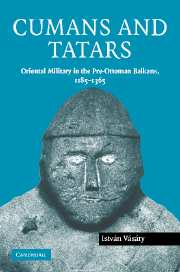Book contents
- Frontmatter
- Contents
- Preface
- 1 Introduction
- 2 Cumans and the Second Bulgarian Empire
- 3 Cumans in the Balkans before the Tatar conquest, 1241
- 4 The first period of Tatar influence in the Balkans, 1242–1282
- 5 The heyday of Tatar influence in the Balkans, 1280–1301
- 6 Cumans and Tatars on the Serbian scene
- 7 Cumans in Byzantine service after the Tatar conquest, 1242–1333
- 8 The Tatars fade away from Bulgaria and Byzantium, 1320–1354
- 9 The emergence of two Romanian principalities in Cumania, 1330, 1364
- Conclusion
- Appendix 1 List of geographical names
- Appendix 2 Chronological table of dynasties
- Appendix 3 Maps
- List of abbreviations
- Bibliography
- Index
9 - The emergence of two Romanian principalities in Cumania, 1330, 1364
Published online by Cambridge University Press: 29 July 2009
- Frontmatter
- Contents
- Preface
- 1 Introduction
- 2 Cumans and the Second Bulgarian Empire
- 3 Cumans in the Balkans before the Tatar conquest, 1241
- 4 The first period of Tatar influence in the Balkans, 1242–1282
- 5 The heyday of Tatar influence in the Balkans, 1280–1301
- 6 Cumans and Tatars on the Serbian scene
- 7 Cumans in Byzantine service after the Tatar conquest, 1242–1333
- 8 The Tatars fade away from Bulgaria and Byzantium, 1320–1354
- 9 The emergence of two Romanian principalities in Cumania, 1330, 1364
- Conclusion
- Appendix 1 List of geographical names
- Appendix 2 Chronological table of dynasties
- Appendix 3 Maps
- List of abbreviations
- Bibliography
- Index
Summary
CUMANS AND TATARS IN ROMANIAN HISTORY
The territories stretching east and south of the Carpathian ranges met a peculiar historical fate in the second millennium. Now, for the most part, these territories are within the boundaries of present-day Romania, which was founded in 1859 by the union of the two Danubian principalities of Wallachia and Moldavia. The territory between the rivers Prut and Dniestr, called Bessarabia after its Russian conquest in 1812, lay for a long time under Russian, then Romanian, then Soviet suzerainty, but gained independence as the state of Moldoa in 1991. The Principality of Wallachia (1330–1859) comprised two geographical units: Oltenia is the territory between the Carpathian Mountains, the Danube and the river Olt (it was the medieval Banate of Severin/Szörény in the thirteenth and fourteenth centuries under the tutelage of the Hungarian kings), while Muntenia comprised the territory east of the Olt. The north-eastern borders of Wallachia, separating it from Moldavia, stretched along the river Buzău. The Principality of Moldavia lay between the Carpathian ranges, the rivers Dniester and Danube, and the Black Sea. The plain region north of the Danube delta, favourable for nomadic cattle-breeders, was called Bužak (now Bugeac in Romanian), a Turkic term meaning ‘corner’. Finally, Dobrudja (now Dobrogea in Romanian), the territory south of the Danube delta, historically always part of Bulgaria, became part of Romania after the First World War.
- Type
- Chapter
- Information
- Cumans and TatarsOriental Military in the Pre-Ottoman Balkans, 1185–1365, pp. 134 - 165Publisher: Cambridge University PressPrint publication year: 2005

